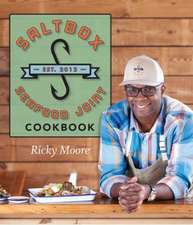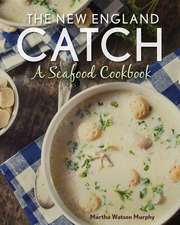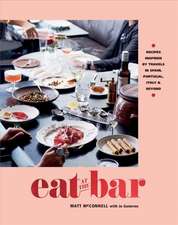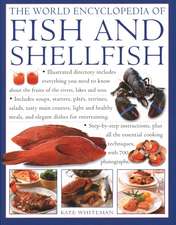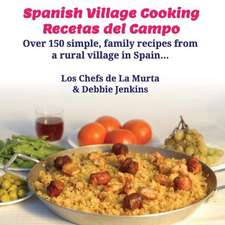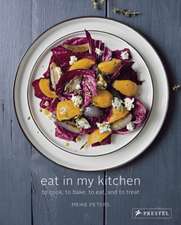Oysters: A Celebration in the Raw
Autor Jeremy Sewall, Marion Lear Swaybill Fotograf Scott Snideren Limba Engleză Hardback – noi 2016
For centuries, oysters have had the power to sustain and delight, inspiring writers and artists, lowly cooks and four-star chefs, laborers and gourmands, and everyone in between. A feast for the eyes and the palate oysters also are rich in history and lore. In Oysters: A Celebration in the Raw, Marion Lear Swaybill presents a wide-ranging visual exploration of this iconic shellfish, including stunning portraits of more than fifty oyster varietals, the latest photographs from some of the country’s most renowned and beautiful oyster farms, and notable illustrations of oysters in the arts and culture, all alongside a lively and informative text. Acclaimed chef and restaurateur Jeremy Sewall provides personal insights, drawing on his New England lineage and his stature in the forefront of the current oyster revival.
Oysters: A Celebration in the Raw is true to its title from start to finish. Chapter One is a primer on all things oyster. Chapter Two introduces readers to legendary oystermen and women from around the country. Chapter Three offers exquisite photographs of more than fifty varieties of North American oysters, along with flavor profiles and ”merroir.” Oysters: A Celebration in the Raw concludes with highlights from the oyster timeline, depictions of oysters in art through the ages and stories of oysters as aphrodisiacs, and parses oyster myths and metaphors. The book also features an oyster glossary and resource list. It is the only book of its kind—a definitive visual companion to this iconic, much loved mollusk.
Overflowing with gorgeous original photography and fascinating anecdotes, Oysters: A Celebration in the Raw is the perfect book for oyster aficionados and newbies, foodies and chefs of all stripes, lovers of photography and art, the environment, history, and the sea.
Oysters: A Celebration in the Raw is true to its title from start to finish. Chapter One is a primer on all things oyster. Chapter Two introduces readers to legendary oystermen and women from around the country. Chapter Three offers exquisite photographs of more than fifty varieties of North American oysters, along with flavor profiles and ”merroir.” Oysters: A Celebration in the Raw concludes with highlights from the oyster timeline, depictions of oysters in art through the ages and stories of oysters as aphrodisiacs, and parses oyster myths and metaphors. The book also features an oyster glossary and resource list. It is the only book of its kind—a definitive visual companion to this iconic, much loved mollusk.
Overflowing with gorgeous original photography and fascinating anecdotes, Oysters: A Celebration in the Raw is the perfect book for oyster aficionados and newbies, foodies and chefs of all stripes, lovers of photography and art, the environment, history, and the sea.
Preț: 158.58 lei
Nou
Puncte Express: 238
Preț estimativ în valută:
30.35€ • 32.95$ • 25.49£
30.35€ • 32.95$ • 25.49£
Carte disponibilă
Livrare economică 02-16 aprilie
Preluare comenzi: 021 569.72.76
Specificații
ISBN-13: 9780789212498
ISBN-10: 0789212498
Pagini: 216
Dimensiuni: 203 x 203 x 25 mm
Greutate: 0.89 kg
Editura: Abbeville Publishing Group
Colecția Abbeville Press
ISBN-10: 0789212498
Pagini: 216
Dimensiuni: 203 x 203 x 25 mm
Greutate: 0.89 kg
Editura: Abbeville Publishing Group
Colecția Abbeville Press
Cuprins
Table of Contents
Author’s Note
Introduction
Chapter 1: About Oysters
Chapter 2: Oystermen
Chapter 3: Simply Oysters
Chapter 4: Oyster Stories
Notes
Glossary
Resources
Acknowledgments
Index
Author’s Note
Introduction
Chapter 1: About Oysters
Chapter 2: Oystermen
Chapter 3: Simply Oysters
Chapter 4: Oyster Stories
Notes
Glossary
Resources
Acknowledgments
Index
Recenzii
“Oysters are back, and luckily writer Marion Lear Swaybill and Chef Jeremy Sewall are here to celebrate one of the few food groups chefs are happy to leave alone, knowing they are best eaten cold and raw”
—Eli Zabar, New York’s neighborhood grocer
“One can only say, ‘About time!’ It is a delight to have a book that treats this beloved mollusk from every possible standpoint. It is at once a field guide and an eater's companion, an entertaining romp, and a cookbook for those who like it raw. We've long been awaiting a volume such as this. The marvelous photographic gallery, revealing the character of each of dozens of oyster varieties, would by itself be enough, but this is ever so much more. Truly a pearl.” — Nach Waxman, Founding Partner of Kitchen Arts & Letters
“Though many have a fondness for oysters, Chef Jeremy Sewall and writer Marion Lear Swaybill gush with an outright passion in this love letter to the beloved bivalve. Jeremy, an expert taster and professional oyster pusher, offers up a range of mouth-watering descriptions while Marion puts forth a solid primer covering everything from the rich history of oyster culture in this country to notes on how to identify certain species and, more importantly, how to open and enjoy them. If you’ve been on the hunt for a book that thoughtfully covers all things oyster, you're in good hands.”
— Erin Byers Murray, author of Shucked: Life on a New England Oyster Farm
“The authors’ deep love and knowledge and the incredible photography casts the oyster in an even more beguiling light. It’s truly a work of passion and art.”
—Barton Seaver, author of the best-selling Cod and Country: Simple, Delicious, Sustainable Cooking
Notă biografică
Marion Lear Swaybill is an Emmy award-winning television producer, writer, and pioneering media executive. As Director of Program Acquisitions at PBS station WNET, (1981-1989), Swaybill was on the cutting edge of the food-on-television revolution, introducing New York public television audiences to luminary chefs including Madhur Jaffrey, Lidia Bastianach, Martin Yan, Jacques Pepin, Britain’s memorable "Two Fat Ladies" and many others. A cook as well as a writer, her recipes have appeared in the "Great Cooks Guide" series (Random House) and New England’s "Sound Magazine."
Jeremy Sewall is an award-winning chef and restaurateur based in Boston and two-time James Beard Award nominee. Trained at the Culinary Institute of America, he has cooked in kitchens around the globe, focusing on seasonal ingredients and his New England food heritage. His restaurants Lineage, Eastern Standard, Island Creek Oyster Bar, and Row 34 have received accolades from New York Times, Esquire, Gourmet and The Boston Globe, among others.
Scott Snider is an award-winning natural history filmmaker whose work takes him around the world as an accomplished underwater, long lens, and macro cinematographer. Scott has over 45 major credits for National Geographic, PBS Nature, Discovery Channel, Animal Planet, the National Park Service and others. He is the founder of Half Moon Productions, a film and photography studio based in Charleston, South Carolina.
Jeremy Sewall is an award-winning chef and restaurateur based in Boston and two-time James Beard Award nominee. Trained at the Culinary Institute of America, he has cooked in kitchens around the globe, focusing on seasonal ingredients and his New England food heritage. His restaurants Lineage, Eastern Standard, Island Creek Oyster Bar, and Row 34 have received accolades from New York Times, Esquire, Gourmet and The Boston Globe, among others.
Scott Snider is an award-winning natural history filmmaker whose work takes him around the world as an accomplished underwater, long lens, and macro cinematographer. Scott has over 45 major credits for National Geographic, PBS Nature, Discovery Channel, Animal Planet, the National Park Service and others. He is the founder of Half Moon Productions, a film and photography studio based in Charleston, South Carolina.
Extras
Excerpt from Introduction
I don’t quite remember the very first oyster I ate, but I am pretty sure of when I ate it. I was a culinary student, in fish class. I’m almost certain it was a Gulf oyster, and I don’t think I liked it. I am absolutely sure it was a couple years before I ate my next oyster. It was not a very romantic start to my life in the oyster world.
Now, though, eating oysters is an almost daily occurrence for me. Whether I am tasting a new type or seeing how the seasons might change the flavor profile of some of the staple varietals at my restaurants, oysters are a huge part of my life, and they are a food that is truly special.
My connection with oysters grew over time. In the late 1990s I lived in the San Francisco Bay Area and was a chef in a restaurant that sourced local foods as much as possible. We shopped at local farmers markets, and it was very common for farmers to drop by with freshly picked produce. Oysters became a big part of that time as well, and we exclusively served local Hog Islands from San Francisco’s Tomales Bay. This is really when my relationship with oysters started—being in a boat on Tomales Bay and having Hog Island’s owner John Finger reach into the water, grab an oyster, shuck it, and then hand it to me to eat. It was one of those food moments that I will never forget. That day, I felt like I had discovered something.
Not long after that I opened a small seafood restaurant with the group I was working for. I expanded my oyster horizons, seeking out and tasting as many different oysters as I could get my hands on. I slowly learned that not all oysters are created equal—they take time and care to grow, like most anything of quality. I found a few that I liked and kept the list small, but my knowledge and curiosity about oysters was growing.
In the early 2000s I moved back to Boston to open a seafood restaurant. That’s when I met Skip Bennett and was invited to his oyster farm in Duxbury, Massachusetts. I took a few cooks with me, and we made our way to the farm where I was first introduced to Island Creeks. Skip and a few of his buddies were growing these amazing oysters, and meeting them was another moment of discovery for me. Skip’s genuine passion for growing oysters and his love of the water made him easy to like, and I immediately admired him for his dedication to the craft. That day I had another chance to eat oysters pulled straight from the water, this time in my native New England, and my relationship with oysters began getting serious.
Even then oysters were not that common on restaurant menus; some places had them but few really put love into them. In that way, the evolution of the oyster bar is similar to that of the oyster itself. A look back at the history of the rise, fall, and rise again of the oyster shows the important part it has played as both a food source and a culinary ingredient. Only in the last ten years have oysters returned to their status as an iconic food that is more and more mainstream.
Now oyster bars are popping up in every major city in the world, and that interest in oysters has led to some great things. Fishermen who have made a living on the water for generations and have found it harder to catch enough fish to support their families have been able to turn to growing shellfish, like oysters. Some communities have taken it as a great opportunity to keep up working waterfronts they have known for generations. Chefs and restaurateurs, who have helped this revival by providing a place to serve oysters, as well as the people that eat them, all play an important role in that story.
Beyond their popularity, oysters do great things for the water they grow in, and even though I hate using the word “sustainable” to describe seafood, oysters are exactly that. Oysters, like anything that is farmed, face challenges from the environment, predators, the weather, and more. Watching how farmers have adapted and gotten better at the craft of growing has been an amazing experience. Skip Bennett is a great example of this; he is behind the famous Island Creek Oysters but has gone on to cultivate Row 34s and Aunt Dotty’s, both from the same species but grown differently, giving them distinct flavors and appearances.
These days Skip and I have several oyster bars with our friends and business partners Shore Gregory and Garrett Harker. We source oysters from all over, and are always excited to taste a new one or hear the story of who grows them and how they got into it. I look at an oyster list like someone might approach a wine list: different geography, flavor profiles, and sizes. On our menus we list the grower along with the oyster, and we will talk endlessly about them to whoever will listen. Educating the staff on oysters is a big part of what we do at the restaurants, and I love hearing them talk to our guests as if they grew each oyster themselves. A couple days each year we put the staff on a bus and send them to Duxbury to experience the process firsthand. They always come back with a great appreciation for the farm and what it takes to grow an oyster. Someone always tells the story of how they ate their first oyster pulled right from the water—just like I did all those years ago.
Each oyster tells a story, and as you look through this book, I hope your love affair, or maybe just an appreciation for these amazing creatures, starts and grows. Experience oysters—the beauty of the shells, the effort that goes into growing them, and the dedication of those who serve them. With oysters, each step in the process is just as important as the next.
I don’t quite remember the very first oyster I ate, but I am pretty sure of when I ate it. I was a culinary student, in fish class. I’m almost certain it was a Gulf oyster, and I don’t think I liked it. I am absolutely sure it was a couple years before I ate my next oyster. It was not a very romantic start to my life in the oyster world.
Now, though, eating oysters is an almost daily occurrence for me. Whether I am tasting a new type or seeing how the seasons might change the flavor profile of some of the staple varietals at my restaurants, oysters are a huge part of my life, and they are a food that is truly special.
My connection with oysters grew over time. In the late 1990s I lived in the San Francisco Bay Area and was a chef in a restaurant that sourced local foods as much as possible. We shopped at local farmers markets, and it was very common for farmers to drop by with freshly picked produce. Oysters became a big part of that time as well, and we exclusively served local Hog Islands from San Francisco’s Tomales Bay. This is really when my relationship with oysters started—being in a boat on Tomales Bay and having Hog Island’s owner John Finger reach into the water, grab an oyster, shuck it, and then hand it to me to eat. It was one of those food moments that I will never forget. That day, I felt like I had discovered something.
Not long after that I opened a small seafood restaurant with the group I was working for. I expanded my oyster horizons, seeking out and tasting as many different oysters as I could get my hands on. I slowly learned that not all oysters are created equal—they take time and care to grow, like most anything of quality. I found a few that I liked and kept the list small, but my knowledge and curiosity about oysters was growing.
In the early 2000s I moved back to Boston to open a seafood restaurant. That’s when I met Skip Bennett and was invited to his oyster farm in Duxbury, Massachusetts. I took a few cooks with me, and we made our way to the farm where I was first introduced to Island Creeks. Skip and a few of his buddies were growing these amazing oysters, and meeting them was another moment of discovery for me. Skip’s genuine passion for growing oysters and his love of the water made him easy to like, and I immediately admired him for his dedication to the craft. That day I had another chance to eat oysters pulled straight from the water, this time in my native New England, and my relationship with oysters began getting serious.
Even then oysters were not that common on restaurant menus; some places had them but few really put love into them. In that way, the evolution of the oyster bar is similar to that of the oyster itself. A look back at the history of the rise, fall, and rise again of the oyster shows the important part it has played as both a food source and a culinary ingredient. Only in the last ten years have oysters returned to their status as an iconic food that is more and more mainstream.
Now oyster bars are popping up in every major city in the world, and that interest in oysters has led to some great things. Fishermen who have made a living on the water for generations and have found it harder to catch enough fish to support their families have been able to turn to growing shellfish, like oysters. Some communities have taken it as a great opportunity to keep up working waterfronts they have known for generations. Chefs and restaurateurs, who have helped this revival by providing a place to serve oysters, as well as the people that eat them, all play an important role in that story.
Beyond their popularity, oysters do great things for the water they grow in, and even though I hate using the word “sustainable” to describe seafood, oysters are exactly that. Oysters, like anything that is farmed, face challenges from the environment, predators, the weather, and more. Watching how farmers have adapted and gotten better at the craft of growing has been an amazing experience. Skip Bennett is a great example of this; he is behind the famous Island Creek Oysters but has gone on to cultivate Row 34s and Aunt Dotty’s, both from the same species but grown differently, giving them distinct flavors and appearances.
These days Skip and I have several oyster bars with our friends and business partners Shore Gregory and Garrett Harker. We source oysters from all over, and are always excited to taste a new one or hear the story of who grows them and how they got into it. I look at an oyster list like someone might approach a wine list: different geography, flavor profiles, and sizes. On our menus we list the grower along with the oyster, and we will talk endlessly about them to whoever will listen. Educating the staff on oysters is a big part of what we do at the restaurants, and I love hearing them talk to our guests as if they grew each oyster themselves. A couple days each year we put the staff on a bus and send them to Duxbury to experience the process firsthand. They always come back with a great appreciation for the farm and what it takes to grow an oyster. Someone always tells the story of how they ate their first oyster pulled right from the water—just like I did all those years ago.
Each oyster tells a story, and as you look through this book, I hope your love affair, or maybe just an appreciation for these amazing creatures, starts and grows. Experience oysters—the beauty of the shells, the effort that goes into growing them, and the dedication of those who serve them. With oysters, each step in the process is just as important as the next.



